The Story of Herb Pharm’s Expo West booth, part 1
This is the first in our series following Herb Pharm’s booth planning process. The next in the series can be found here. And the final post, “Sustainability at Trade Shows: An Oxymoron?” is here.
by Ann Armbrecht, SHP Director
A Sea of Stuff
I first attended Expo West in 2019. I’d been warned it would be overwhelming but nothing prepared me for the scale of the stuff and the scale of people paying attention to that stuff. Hall after hall was lined with row after row of booths, you could find them by numbers on the floor which reached into the thousands. Each booth sported an elaborate display promoting the latest natural product, snack bars or chocolate or some new kind of sports drink or vitamin or coffee or kombucha or elderberry gummies or CBD oil or herbal extract or chocolate.
In the midst of this sea of stuff, I came upon Herb Pharm’s booth which was like arriving at a garden in the center of downtown Manhattan
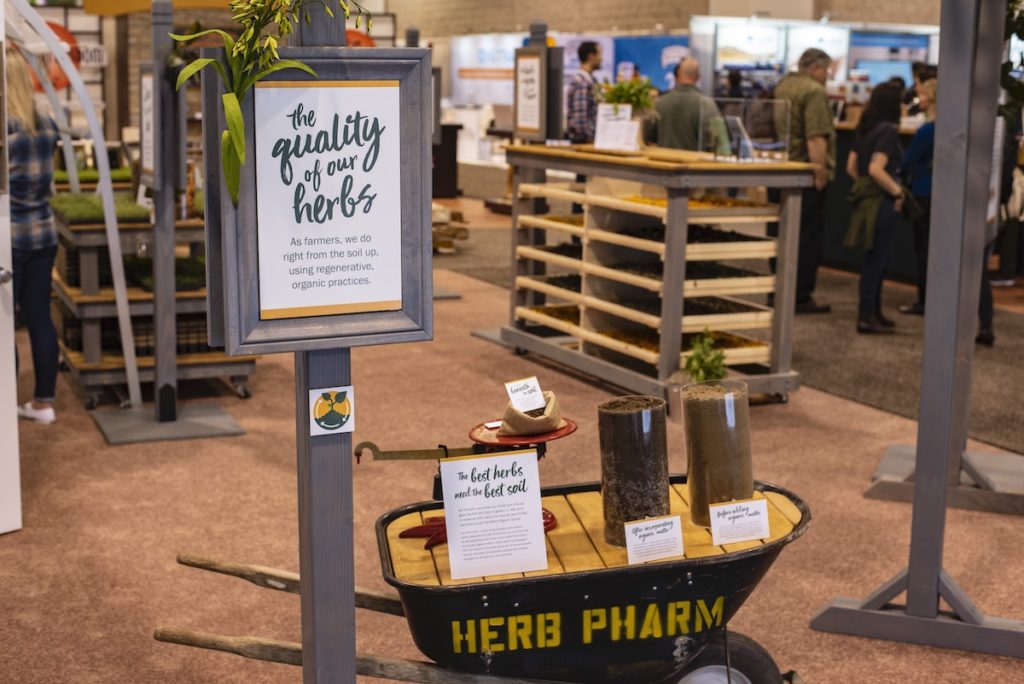
Herb Pharm’s booth at the 2019 Expo West trade show. Their booth was a series of educational stations created to give viewers a sensory experience of the plants and process of growing, harvesting and processing those plants.
Unlike other booths, here I found soil and seedings and seeds. A display of racks filled with calendula and nettles demonstrated how they dried their herbs (though they make a point of trying to re-use everything in their booth, they did not re-use those herbs, I was told). Large placards shared information about regenerative agriculture and why they had been out of goldenseal. At the front was a row of tinctures where they shared tastes of their different herbs.
It was beautiful and, despite the crowd, felt peaceful.
Nuts and Bolts of Designing a Trade Show Booth
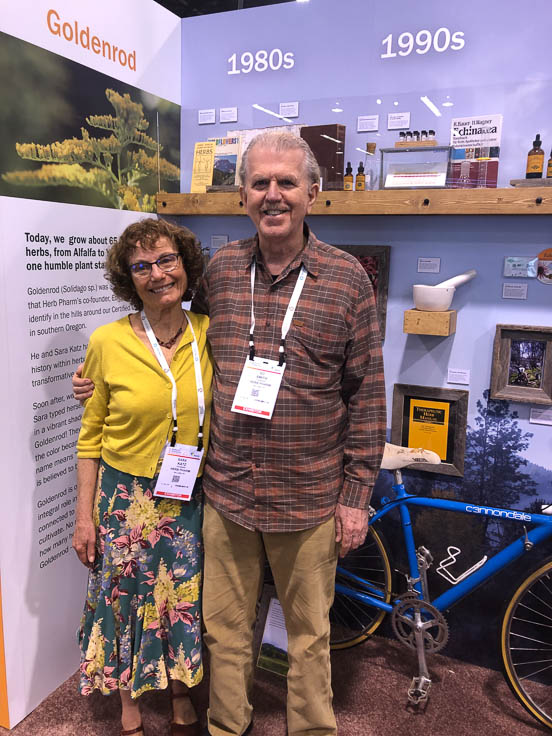
Herb Pharm was started 40 years ago by Ed Smith and Sara Katz. The 2019 booth included an historical display of the past 40 years, with copies of an early calendar, logo designs over the years, photos, shovels and Sara’s bicycle. Photo by Steven Foster.
When I returned home, I contacted Tal Johnson, CEO of Herb Pharm, to talk about writing something on the philosophy behind their booth. He came back with an invitation—was I interested in listening in on their planning for next year’s Expo booth? That way, he said, I could not just write about what they had done. More importantly and more interestingly, he thought, I could write about their process for deciding what they will do. It would be a lot more impactful, he imagined, to offer insight into how their vision gets expressed in the nuts and bolts of a trade show booth, the tradeoffs they make, where they compromise, and when they don’t.
Herb Pharm is committed to reducing their environmental impact. But more importantly, he said, he is interested in inspiring the industry as a whole to think about the environmental impact of trade shows. And this seemed like a way to help do that.
I was intrigued and readily agreed.
What are We Doing? And Why Isn’t It Getting Attention?
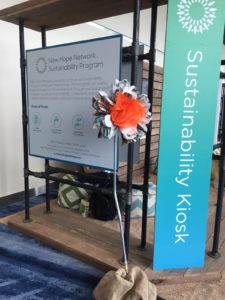
The New Hope Sustainability Program kiosk at the 2019 show. More information on this program is at the bottom of this post.*
Tal’s first experience with Expo was a last-minute decision. It was 1995 and he had just joined Tazo Tea as CEO. They decided they should go to Expo but, since Tazo didn’t have the funds, he put $3000 or $4000 on his VISA card so Steve Smith, Tazo’s founder, and Erik Lee, their sales manager, could go. They didn’t have or time or money for a booth, so they loaded a van with things from the warehouse and office, using furniture and displays originally made for other purposes. They got creative in unintentionally sustainable ways.
Three-thousand people attended the first Expo West in 1981. Thirty-eight years later, at least 86,000 attend. This doesn’t count the staff working in the booths. Companies now compete to build the most creative, newest, biggest booth. The CEO of one company told me it cost them $70,000 to attend and have a booth at Expo. But they can’t afford not to be there.
Tal remembers one morning walking into the show before it opened. People were handing out samples to passersby who took one bite before throwing the rest in the waste can. They got another sample at the next booth, and once again threw it into the trash. The trash cans overflowed. I shifted in my chair as I remembered doing the same thing myself.
“It was really good food,” he said. And it was all going to waste. “What are we doing?” he wondered. “And why isn’t this getting more attention?”
Turning the Titanic
“On one hand,” Tal said, “You could say just don’t go to Expo.” But a lot of good things happen at Expo, especially around education and the programming that Climate Collaborative organizes on Climate Day (register now for 2020). It’s a place to learn about new and important initiatives, like regenerative organic certification, which Herb Pharm is now piloting. Herb Pharm staff are able to have face to face meetings with others in the industry, which is invaluable. The trade show brings people together in a way that can lead to important changes and so as a company they plan to stay engaged. But they are committed to reducing their environmental impact. And, they want to see if their exploration can inspire the natural products industry to think hard about its impact.
“I would be really happy if we could help turn the Titanic and play a part in helping the industry to remember its roots and the reasons why many of us got involved in this work in the first place,” Tal said.
The Importance of Transparency
I sat in on their first planning meeting in mid-November and will continue to do so until the show in March. I’ll share my reflections through a series of posts shared on the SHP site. I am listening in not as a journalist hoping to find dirt to share. I am sharing what I write with Tal and Matt Palomares, the head of marketing who leads the planning process for their presence at Expo, to get their input. I’m doing so because I am as interested in the actual decisions they make around reducing their impact at the show as I am in their willingness to share their process about their decision making.
From what I have found, that willingness to be transparent is the single most important step that companies can take to begin to move the needle in becoming more responsible, not just in their trade show presence, but in their impact on the environment as a whole. And so, I am intrigued by the broader potential that sharing this process might have, what the risks are, and what the possible benefits are.
Butterflies
Many companies are only partly transparent. They share the stories that look good where they are already sure of the outcome. Tal has invited me to listen in on their conversations where they have no idea what will come up.
For example, in the first call I learned that the greenhouse they were so glad to build because they planned to re-use it on the farm in fact isn’t sturdy enough to use as a functioning greenhouse and so to date has not yet been put to use. Or that a lot of the materials used in their booth can’t be recycled at the center in Williams, Oregon, which means additional work for employees who have to drive the material to another location where it can be recycled. Matt led the group on the call through a history of the booths they had used. When a photo of the booth with hundreds of beautiful monarch butterflies came up, he laughingly referred to not wanting to trigger any stress from the memory of how painstaking making the butterflies had been.
What lessons can be learned when the challenges and not just the successes are shared?
Process over Product
Not only does the transparency seem important. I am also interested in the relationship between understanding the process and appreciating the product.
This year their goal with their Expo West booth is to significantly reduce their climate impact in a creative way while still meeting their commercial objectives. “It’s not easy,” Tal added in his introduction to the Marketing, Sales, and Herbalist team. “If it were, people would have already made more progress.”
It is easy to stand on the outside and demand companies to be more responsible. It is much, much harder to actually implement responsible practices. Every action has consequences. How a company weighs those consequences, how they learn from decisions that had ones they didn’t anticipate—like the green house or challenges with recycling—matters as much for the journey toward building regenerative business models as getting those decisions right in the first place. That journey then becomes part of the product—one we can carry with us, leaving nothing behind in the garbage.
*The New Hope Sustainability Program includes information on ways they are working to reduce the environmental impacts of the trade show, guides for exhibitors and attendees to reduce those impacts , and ways to get involved. If you are an exhibitor or attendee to the show, take a look to see how you can support these efforts and let them know they matter!
All photos unless otherwise specified are by Herb Pharm.

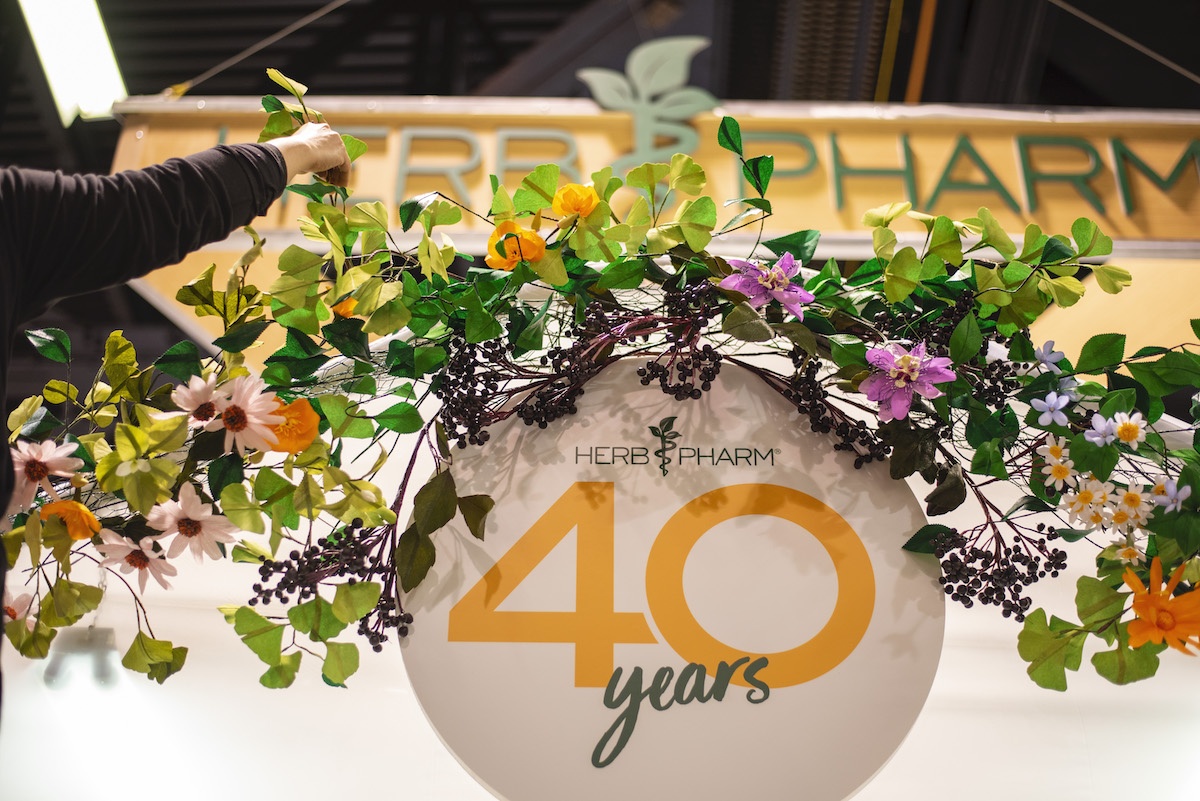
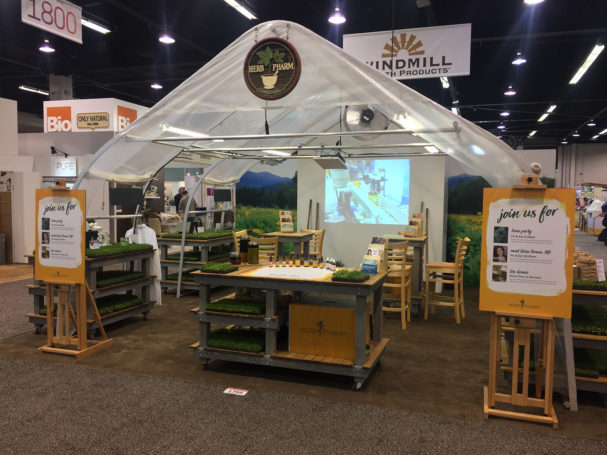

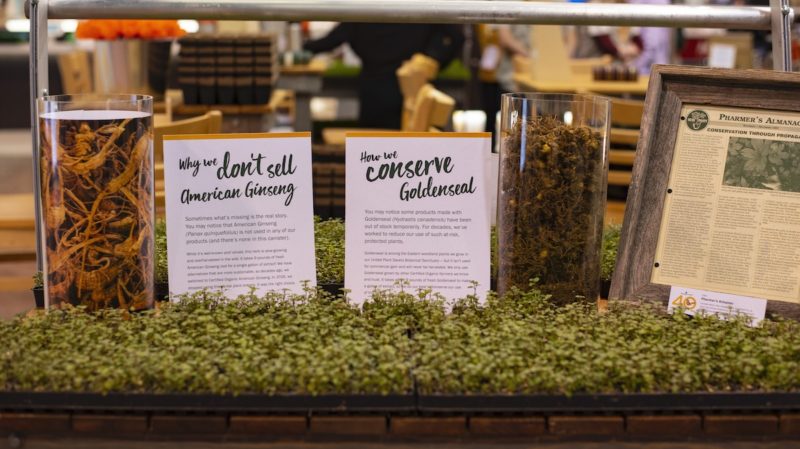
Hi Ann,
Found this inspiring for my future trade show booths. Hope you are well- Happy New Year!
Good to know! Too bad they never were able to use it… Hope you are doing well as well. B